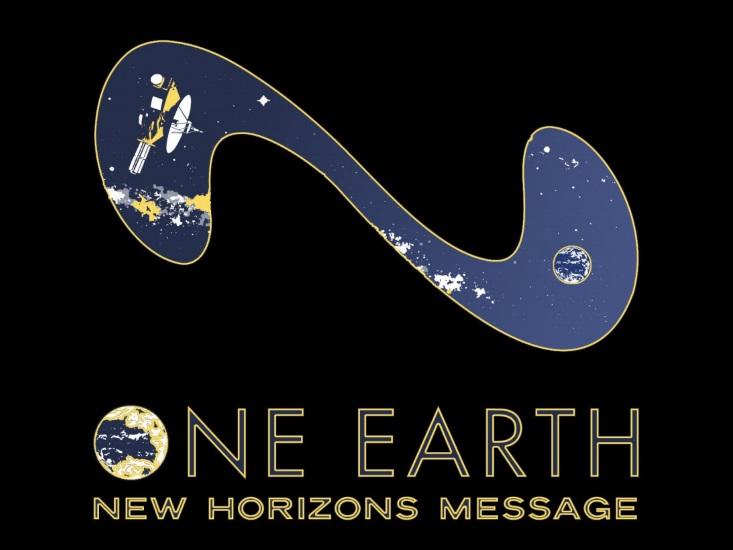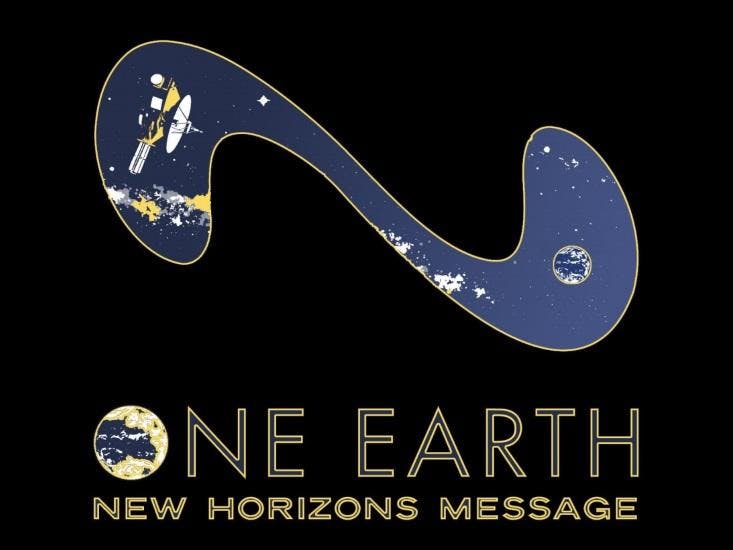Now that New Horizons has completed its flyby of Pluto, the spacecraft is on a long journey to become the fifth manmade object to leave the solar system. It does so carrying some curious human artifacts: a Florida state quarter, an American flag, and one ounce of the ashes of Clyde Tombaugh, who discovered Pluto in 1930. One thing New Horizons is not carrying, however, is a message from humanity to extraterrestrial life. Jon Lomberg thinks that’s a missed opportunity. As project director for the One Earth Message, he would like to change that.
Lomberg was Carl Sagan’s principal artistic collaborator for a quarter century. He’s also one of the world’s few experts on “deep-time messages”: missives intended for civilizations far removed in time and space. In 1977 he served alongside Sagan as design director for the Voyager Golden Record. Together with a multidisciplinary team, they created a phonograph record that is encoded with images, diagrams, natural sounds and human speech: a portrait of human life and our planet. The gold-plated records and instructions on how to interpret them were launched with space probes Voyager 1 and 2. (The instructions are not encoded, but carved into the surface as visible images.) The former is now the furthest manmade object from earth, and the Golden Record has become a symbol of science’s romantic potential, a rare human undertaking that reminds us how small we are in space even as it illustrates our limitless imagination.
So when New Horizons launched in 2006 without a message for extraterrestrial life, Lomberg was surprised—and disappointed. “I expected they would have some quantum, nano-, super-conducting update of the Golden Record,” Lomberg told me by phone this week. “And they didn’t have any sort of message on it.”
Lomberg launched the One Earth Message (OEM) project, with the goal of creating “a self-portrait of humanity to send to the stars,” a “Voyager Golden Record 2.0,” written as digital information and uploaded to New Horizons.

The OEM is not intended to be a replica, though. For starters, a small team created the Voyager records. “Kind of presumptuous” to speak for the entire planet, says Lomberg. The OEM will be crowdsourced instead. Anyone with an Internet connection will be able to submit photographs and vote on the submissions of others.
An advisory board (pdf) will guide the process by choosing categories—animals, plants, human life, even problems and solutions—and ensuring submissions reflect the true diversity of life on earth. So that, for example, spiders, rats and snakes are represented, not just kittens. Political and hateful messages will be filtered out.
Negative messages won’t, however. The Golden Record has been criticized for presenting a unilaterally sunny image. “[It] was very sanitized,” says Lomberg. “Earth on a good day.” The OEM’s advisory board, by contrast, voted almost unanimously to allow images of sickness, war, starvation, and death, believing their exclusion would be dishonest.
Then there are the technical differences. The records are physical artifacts carried by the Voyager probes. The OEM will be a piece of software sent by radio to New Horizons, just one percent of all data buried in the computer’s memory. The record required no advanced technology to interpret—Lomberg remembers spinning LP’s on pencils as a kid, playing them with a safety pin in the groove—whereas computers require specialized knowledge and equipment. (New Horizons was already seven years into its mission when Lomberg thought of the OEM, so of course it wasn’t possible to include the message as a physical artifact this time.)
The Voyager Golden Record “was very sanitized,” says Lomberg. “Earth on a good day.”
Uploading such an information-dense message to a spacecraft beyond Pluto will take months, if not years. The full of package of data and photographs New Horizons is sending back from Pluto will take 18 months to reach us.
But Alan Stern, Principle Investigator for the New Horizons mission, says it’s technically possible. He’s given his public support for the OEM. When Lomberg and his advisory team of scientists, engineers, educators, and artists gathered more than 10,000 signatures asking NASA to upload the message, NASA said they would, but they aren’t going to fund it. Instead, the OEM Project turned to a tool unavailable in the Voyager era: crowdfunding.
The OEM’s campaign on Fiat Physica—a new crowd-funding platform that supports science-related projects—ends this week. They’re seeking an initial $500,000 to fund technical research, like creating a submissions website and a way to compress files such that that beings unfamiliar with jpegs will be able to uncompress them.
The campaign also includes stretch goals up to $2.6 million. This funding would support global education and outreach about the project—including offline inclusionary campaigns to gather the perspectives of indigenous people in remote parts of the world.
“What news story in the past month made you feel this good?”
As of now, though, three days and five hours from the deadline, the project has only raised $17,625. Lomberg suspects that may be because NASA has yet to publicly endorse the project, though some employees offer private statements of support. Now that all eyes are on New Horizons, Lomberg hopes NASA promotes the OEM as a way to harness the interest and wonder the mission has inspired.
Ultimately, he believes, that’s the greatest good a project like this can achieve. Space travel is cross-culturally inspiring, like the Olympics; it reminds people of our common fate on a shared planet. Speaking of the Pluto flyby, Lomberg asks, “What news story in the past month made you feel this good? It’s like seeing a gymnast nail a perfect routine: people at their best doing something really, really difficult.”
Jen Kinney writes about infrastructure, housing, and other urban innovations for Next City.



